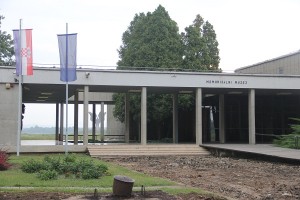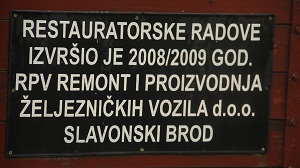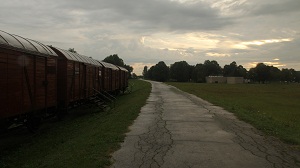After wild camping near to the the Lonjsko Polje Nature Park, we set off next morning, despite the rain, for our 70 km cycling day along the Sava river. En route a few of us took the opportunity to visit a local social anthropology/ ethnographic museum in someone’s back garden. Without any common language we were able to communicate through hands-on demonstrations of some of the tools and equipment from the owner’s lifetime. The museum contained hundreds of examples of D.I.Y handmade crafts and tools used for creating cloth from plants, furniture without fixings, embroidery and fabrics from 4 generations of the owner, as well as tools used for making wine, milk, grain and flour, and even a wooden door lock that was 200 years old!
Later in the day some took the opportunity to visit a monument, in the form of a huge stone flower, for the victims of Jasenovac extermination camp during WW2. In the cloud-filled sky it was an atmospheric and sobering experience witnessing the existing mounds where buildings once existed, and the train used to bring persecuted ethnic Serbs, Jews and Roma people to their death.
At the border crossing into Bosnia, a few of us stopped to interview a Serbian man who was living in Bosnia and working in Croatia, who told us more about the concentration camp and his experience of living and working across the border.
Just after the border this sign amused us…















Actually, in Jasenovac they were mostly in the business of persecuting Serbs, but its all complicated.